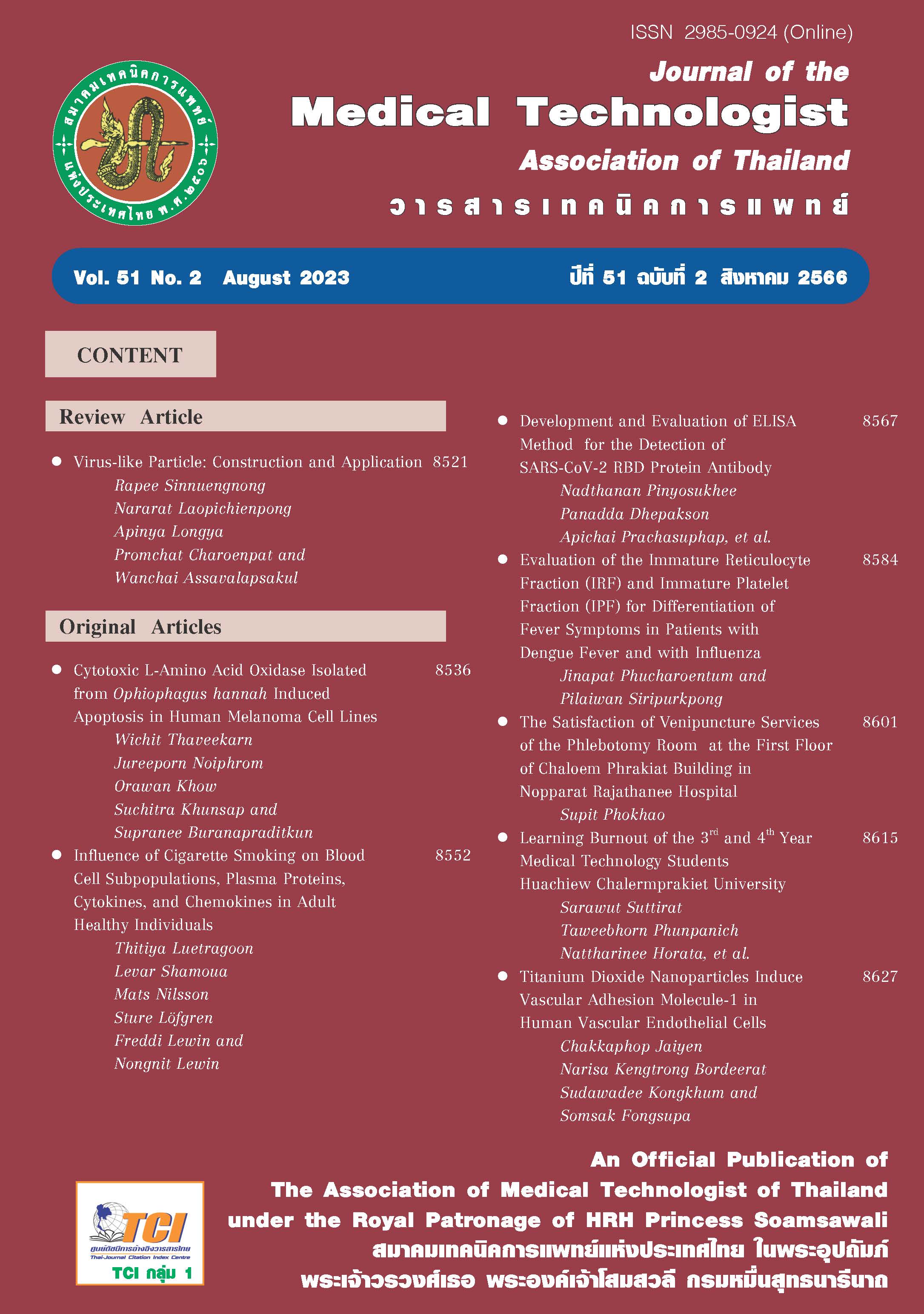L-amino acid oxidase จากพิษงูจงอางสามารถเหนี่ยวนำให้เกิดการตายแบบ apoptosis ในเซลล์มะเร็งผิวหนังมนุษย์
คำสำคัญ:
L-amino acid oxidase, งูจงอาง, การตายแบบ apoptosis, เซลล์มะเร็งผิวหนังบทคัดย่อ
L-amino acid oxidase (LAAO) เป็นส่วนประกอบหนึ่งในพิษงูที่มีความเป็นพิษต่อเซลล์ การศึกษาเกี่ยวกับสารต้านมะเร็งผิวหนังในประเทศไทยยังมีไม่มากนัก งูจงอางเป็นงูพิษที่มีขนาดใหญ่ ปริมาณน้ำพิษมีมาก การศึกษานี้มีวัตถุประสงค์เพื่อศึกษาผลของ LAAO จากพิษงูจงอางต่อเซลล์ผิวหนังปกติและเซลล์มะเร็งผิวหนัง โดยแยก LAAO จากพิษงูจงอางด้วยเทคนิคโครมาโทกราฟีตามขนาดน้ำหนัก โมเลกุล การใช้ตัวแลกเปลี่ยนประจุ และการจับกันอย่างจำเพาะ ทำการทดสอบ LAAO ในเซลล์ทั้งสองชนิด และตรวจวัดความเป็นพิษต่อเซลล์ด้วยวิธี MTT assay พบว่า ที่เวลา 48 ชั่วโมง LAAO จากพิษงูจงอางไม่ทำให้เซลล์ผิวหนังปกติตาย แต่ทำให้เซลล์มะเร็งผิวหนังตายประมาณร้อยละ 27 และจากการตรวจสอบ phosphatidyl serine ด้วยเครื่อง flow cytometry พบการตายของเซลล์ทั้งสองชนิดเป็น แบบ apoptosis โดยการตายของเซลล์เกี่ยวข้องกับ H2O2 ที่เกิดขึ้น ซึ่งเกิดจากปฏิกิริยาของ LAAO การใช้เอนไซม์ catalase ทดสอบสามารถป้องกันการตายของเซลล์ที่เกิดขึ้นจาก LAAO ได้ เมื่อตรวจสอบ โปรตีนที่เกี่ยวข้องกับการตายแบบ apoptosis พบการย้าย cytochrome c จากไมโทคอนเดรียไปสู่ไซโตซอล และมีการแสดงออกของโปรตีน Bcl-2 ลดลง ดังนั้นอาจกล่าวได้ว่า LAAO จากพิษงูจงอางมีศักยภาพในการต้านมะเร็งผิวหนัง ซึ่งอาจพัฒนาต่อเพื่อใช้เป็นสารยับยั้งเซลล์มะเร็งผิวหนังได้
เอกสารอ้างอิง
Singer TP, Kearney EB. The L-amino acid oxidases of snake venom. II. Isolation and characterization of homogenous L-amino acid oxidase. Biochem. 1950; 29: 190-209.
Fung SY, Lee ML, Tan NH. Molecular mechanism of cell death induced by King Cobra (Ophiophagus hannah) venom L-amino acid oxidase. Toxicon. 2015; 96:38–45.
Sakurai Y, Takatsuka H, Yoshioka A, Matsui T, Suzuki M, Titani K, et al. Inhibition of human platelet aggregation by L-amino acid oxidase purified from Naja Naja kaouthia venom. Toxicon. 2001;39(12):1827–33.
Carone SEI, Costa TR, Burin SM, Cintra ACO, Zoccal KF, Bianchini FJ, et al. A new L-amino acid oxidase from Bothrops jararacussu snake venom: Isolation, partial characterization, and assessment of pro-apoptotic and Antiprotozoal Activities. International Journal of Biological Macromolecules. 2017; 103:25–35.
Hiu JJ, Yap MK. Cytotoxicity of snake venom enzymatic toxins: Phospholipase A2 and L-amino acid oxidase. Biochemical Society Transactions. 2020;48(2):719–31.
Zhang L, Wei L-J. ACTX-8, a cytotoxic L-amino acid oxidase isolated from Agkistrodon acutus snake venom, induces apoptosis in Hela cervical cancer cells. Life Sciences. 2007;80(13):1189–97.
Tan CH, Bourges A, Tan KY. King cobra and snakebite envenomation: On the natural history, human-snake relationship and medical importance of Ophiophagus hannah. Journal of Venomous Animals and Toxins including Tropical Diseases. 2021; 27.
Du X-Y, Clemetson KJ. Snake venom L-amino acid oxidases. Toxicon. 2002;40(6):659–65.
Pawelek PD. The structure of L-amino acid oxidase reveals the substrate trajectory into an enantiomerically conserved active site. The EMBO Journal. 2000; 19(16):4204–15.
Lee ML, Tan NH, Fung SY, Sekaran SD. Antibacterial action of a heat-stable form of L-amino acid oxidase isolated from king cobra (Ophiophagus hannah) venom. Comparative Biochemistry and Physiology Part C: Toxicology & Pharmacology. 2011; 153(2):237–42.
Tan NH, Saifuddin MN. Isolation and characterization of an unusual form of L-amino acid oxidase from King cobra (Ophiophagus hannah) venom. Biochem Int. 1989; 19(4):937–44.
Tan KK, Ler SG, Gunaratne J, Bay BH, Ponnampalam G. In vitro cytotoxicity of L-amino acid oxidase from the venom of Crotalus mitchellii pyrrhus. Toxicon. 2017; 139:20–30.
Fung, Shin YL, Mui LT, Nget H. Proteomic investigation of the molecular mechanism of king cobra venom L-amino acid oxidase induced apoptosis of human breast cancer (MCF-7) cell line. Indian Journal of Experimental Biology. 2018; 56:101-111.
Wang C, Youle RJ. The role of mitochondria in apoptosis. Annual Review of Genetics. 2009;43(1):95–118.
Li Lee M, Chung I, Yee Fung S, Kanthimathi MS, Hong Tan N. Antiproliferative activity of king cobra (Ophiophagus hannah) venom L-amino acid oxidase. Basic & Clinical Pharmacology & Toxicology. 2013;114(4):336–43.
Lee, M.L., Fung, S.Y., Chung, I., Pailoor, J., Cheah, S.H., Tan, N.H. King Cobra (Ophiophagus hannah) Venom L-Amino Acid Oxidase Induces Apoptosis in PC-3 Cells and Suppresses PC-3 Solid Tumor Growth in a Tumor Xenograft Mouse Model. International Journal of Medical Sciences. 2014; 11(6):593-601.
Barrera G. Oxidative stress and lipid peroxidation products in cancer progression and therapy. ISRN Oncology. 2012; 2012:1–21.
Stark G. Functional consequences of oxidative membrane damage. J Membr Biol. 2005; 205(1):1–16.
Morgan MJ, Kim Y-S, Liu Z-G. TNFalpha and reactive oxygen species in necrotic cell death. Cell Res [Internet]. 2008;18(3):343–9.
Costal-Oliveira F, Stransky S, Guerra-Duarte C, Naves de Souza DL, Vivas-Ruiz DE, Yarlequé A, et al. L-amino acid oxidase from Bothrops atrox snake venom triggers autophagy, apoptosis and necrosis in normal human keratinocytes. Sci Rep. 2019; 9(1):781.
Teramoto S, Tomita T, Matsui H, Ohga E, Matsuse T, Ouchi Y. Hydrogen peroxide-induced apoptosis and necrosis in human lung fibroblasts: protective roles of glutathione. Jpn J Pharmacol. 1999; 79(1):33-40.
Garrido C, Galluzzi L, Brunet M, Puig PE, Didelot C, Kroemer G. Mechanisms of cytochrome c release from mitochondria. Cell Death Differ. 2006; 13(9):1423–33.
Izidoro LFM, Sobrinho JC, Mendes MM, Costa TR, Grabner AN, Rodrigues VM, et al. Snake venom L-amino acid oxidases: trends in pharmacology and biochemistry. Biomed Res Int. 2014; 2014:196754.
Opferman JT, Kothari A. Anti-apoptotic BCL-2 family members in development. Cell Death Differ. 2018; 25(1):37–45.
Allsopp TE, Wyatt S, Paterson HF, Davies AM. The proto-oncogene Bcl-2 can selectively rescue neurotrophic factor-dependent neurons from apoptosis. Cell. 1993; 73(2):295–307.
David GB, Isbelle M. Textbook of Modern Surgical Pathology, 2nd ed, Philadelphia, USA. (ISBN: 978-1-4160-3966-2).
Kane DJ, Sarafian TA, Anton R, Hahn H, Gralla EB, Valentine JS, et al. Bcl-2 inhibition of neural death: decreased generation of reactive oxygen species. Science. 1993; 262(5137):1274–7.
Logue SE, Elgendy M, Martin SJ. Expression, purification and use of recombinant annexin V for the detection of apoptotic cells. Nat Protoc. 2009; 4(9):1383–95.
ดาวน์โหลด
เผยแพร่แล้ว
รูปแบบการอ้างอิง
ฉบับ
ประเภทบทความ
สัญญาอนุญาต
ลิขสิทธิ์ (c) 2023 วารสารเทคนิคการแพทย์

อนุญาตภายใต้เงื่อนไข Creative Commons Attribution-NonCommercial-NoDerivatives 4.0 International License.






